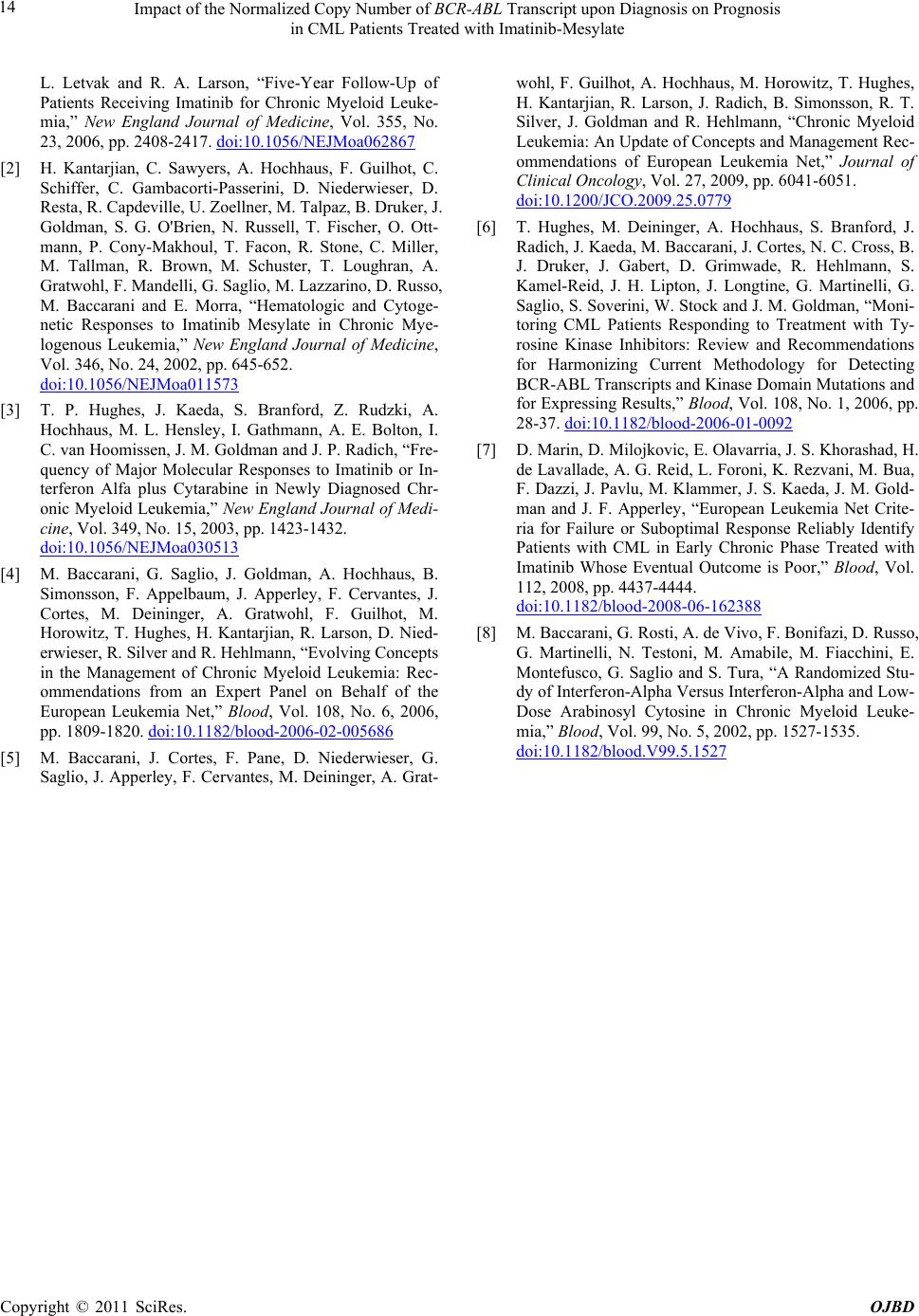
Impact of the Normalized Copy Number of BCR-ABL Transcript upon Diagnosis on Prognosis
in CML Patients Treated with Imatinib-Mesylate
Copyright © 2011 SciRes. OJBD
14
L. Letvak and R. A. Larson, “Five-Year Follow-Up of
Patients Receiving Imatinib for Chronic Myeloid Leuke-
mia,” New England Journal of Medicine, Vol. 355, No.
23, 2006, pp. 2408-2417. doi:10.1056/NEJMoa062867
[2] H. Kantarjian, C. Sawyers, A. Hochhaus, F. Guilhot, C.
Schiffer, C. Gambacorti-Passerini, D. Niederwieser, D.
Resta, R. Capdeville, U. Zoellner, M. Talpaz, B. Druker, J.
Goldman, S. G. O'Brien, N. Russell, T. Fischer, O. Ott-
mann, P. Cony-Makhoul, T. Facon, R. Stone, C. Miller,
M. Tallman, R. Brown, M. Schuster, T. Loughran, A.
Gratwohl, F. Mandelli, G. Saglio, M. Lazzarino, D. Russo,
M. Baccarani and E. Morra, “Hematologic and Cytoge-
netic Responses to Imatinib Mesylate in Chronic Mye-
logenous Leukemia,” New England Journal of Medicine,
Vol. 346, No. 24, 2002, pp. 645-652.
doi:10.1056/NEJMoa011573
[3] T. P. Hughes, J. Kaeda, S. Branford, Z. Rudzki, A.
Hochhaus, M. L. Hensley, I. Gathmann, A. E. Bolton, I.
C. van Hoomissen, J. M. Goldman and J. P. Ra dich, “Fre-
quency of Major Molecular Responses to Imatinib or In-
terferon Alfa plus Cytarabine in Newly Diagnosed Chr-
onic Myeloid Leukemia,” New England Journal of Medi-
cine, Vol. 349, No. 15, 2003, pp. 1423-1432.
doi:10.1056/NEJMoa030513
[4] M. Baccarani, G. Saglio, J. Goldman, A. Hochhaus, B.
Simonsson, F. Appelbaum, J. Apperley, F. Cervantes, J.
Cortes, M. Deininger, A. Gratwohl, F. Guilhot, M.
Horowitz, T. Hughes, H. Kantarjian, R. Larson, D. Nied-
erwieser, R. Silver and R. Hehlmann, “Evolving Concepts
in the Management of Chronic Myeloid Leukemia: Rec-
ommendations from an Expert Panel on Behalf of the
European Leukemia Net,” Blood, Vol. 108, No. 6, 2006,
pp. 1809-1820. doi:10.1182/blood-2006-02-005686
[5] M. Baccarani, J. Cortes, F. Pane, D. Niederwieser, G.
Saglio, J. Apperley, F. Cervantes, M. Deininger, A. Grat-
wohl, F. Guilhot, A. Hochhaus, M. Horowitz, T. Hughes,
H. Kantarjian, R. Larson, J. Radich, B. Simonsson, R. T.
Silver, J. Goldman and R. Hehlmann, “Chronic Myeloid
Leukemia: An Update of Concepts and Management Rec-
ommendations of European Leukemia Net,” Journal of
Clinical Oncology, Vol. 27, 2009, pp. 6041-6051.
doi:10.1200/JCO.2009.25.0779
[6] T. Hughes, M. Deininger, A. Hochhaus, S. Branford, J.
Radich, J. Kaeda, M. Baccarani, J. Cortes, N. C. Cross, B.
J. Druker, J. Gabert, D. Grimwade, R. Hehlmann, S.
Kamel-Reid, J. H. Lipton, J. Longtine, G. Martinelli, G.
Saglio, S. Soverini, W. Stock and J. M. Goldman, “Moni-
toring CML Patients Responding to Treatment with Ty-
rosine Kinase Inhibitors: Review and Recommendations
for Harmonizing Current Methodology for Detecting
BCR-ABL Transcripts and Kinase Domain Mutations and
for Expressing Results,” Blood, Vol. 108, No. 1, 2006, pp.
28-37. doi:10.1182/blood-2006-01-0092
[7] D. Marin, D. Milojkovic, E. Olavarria, J. S. Khorashad, H.
de Lavallade, A. G. Reid, L. Foroni, K. Rezvani, M. Bua,
F. Dazzi, J. Pavlu, M. Klammer, J. S. Kaeda, J. M. Gold-
man and J. F. Apperley, “European Leukemia Net Crite-
ria for Failure or Suboptimal Response Reliably Identify
Patients with CML in Early Chronic Phase Treated with
Imatinib Whose Eventual Outcome is Poor,” Blood, Vol.
112, 2008, pp. 4437-4444.
doi:10.1182/blood-2008-06-162388
[8] M. Baccarani, G. Rosti, A. de Vivo, F. Bonifazi, D. Russo,
G. Martinelli, N. Testoni, M. Amabile, M. Fiacchini, E.
Montefusco, G. Saglio and S. Tura, “A Randomized Stu-
dy of Interferon-Alpha Versus Interferon-Alpha and Low-
Dose Arabinosyl Cytosine in Chronic Myeloid Leuke-
mia,” Blood, Vol. 99, No. 5, 2002, pp. 1527-1535.
doi:10.1182/blood.V99.5.1527